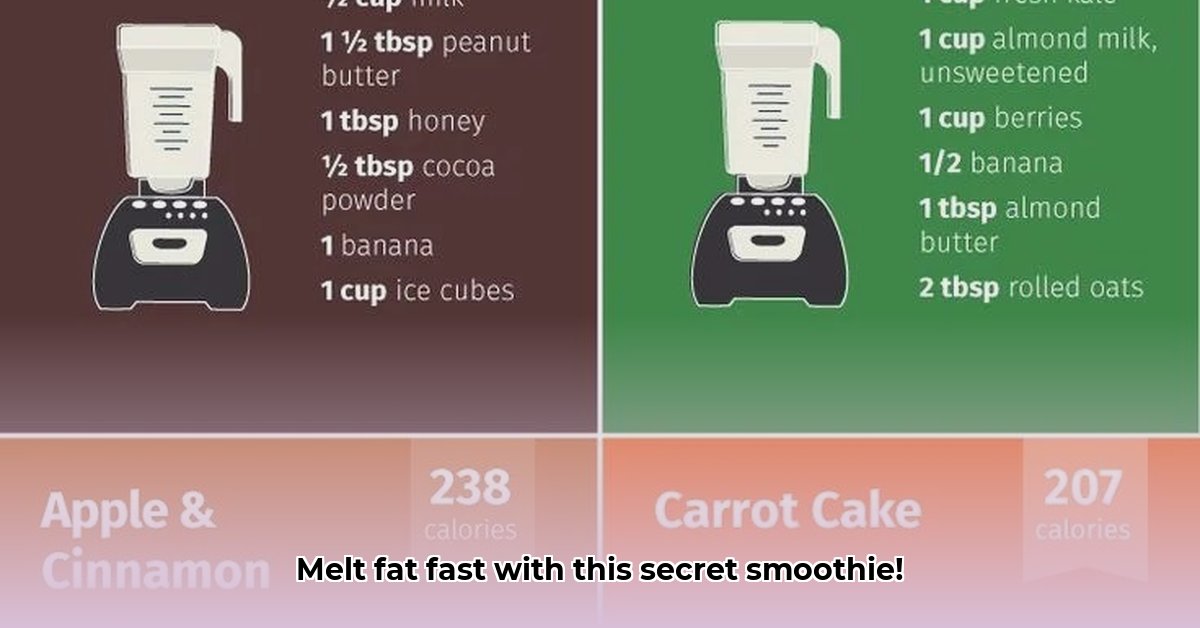
Weight Loss Smoothies: Your Speedy Path to a Healthier You
Ready to shed those extra pounds and feel fantastic? Weight-loss smoothies, when crafted correctly, can be a powerful tool in your weight-loss journey. This expert guide unpacks the science and provides actionable steps to help you achieve your goals. Remember, consistency and a holistic approach are key. Don't expect overnight miracles; this is about building sustainable healthy habits.
Crafting Your Perfect Weight-Loss Smoothie: A Step-by-Step Guide
Here's a simple, yet effective, recipe framework for a high-impact, low-calorie smoothie designed to support your weight loss goals. Remember, portion control is crucial, even with healthy smoothies!
Step 1: Power Up with Protein (20-30 grams): Protein keeps you feeling full and satisfied, curbing cravings. Options include whey, casein, soy, or plant-based protein powders. Why is this important? Studies show that higher protein intake is associated with increased satiety and reduced overall calorie consumption.
Step 2: Choose Your Liquid Wisely: Opt for low-calorie liquids like water, unsweetened almond milk, or unsweetened coconut water. Avoid creamy options loaded with added calories.
Step 3: Add Healthy Fats (Sparingly): A teaspoon or two of nut butter (almond or peanut), chia seeds, or flax seeds adds healthy fats to aid in nutrient absorption and satiety.
Step 4: Fruit – Moderation is Key: While fruits offer vitamins, be mindful of their sugar content. Berries are your best bet, being lower in sugar than other fruits.
Step 5: Leafy Greens – Your Nutritional Powerhouse: Spinach, kale, or romaine lettuce pack essential nutrients with minimal calories. These often go unnoticed in a well-blended smoothie.
Step 6: Optional Boosters: Consider fiber-rich ingredients like psyllium husk or chia seeds to further enhance satiety.
Sample Recipe (approximately 300 calories):
| Ingredient | Amount | Notes |
|---|---|---|
| Unsweetened Almond Milk | 1 cup | Provides liquid base and some nutrients |
| Whey Protein Powder | 1 scoop (vanilla) | Provides essential protein |
| Mixed Berries | ½ cup | Lower in sugar than many other fruits |
| Spinach | 1 cup | Adds vitamins and minerals, minimal calories |
| Almond Butter | 1 tablespoon | Adds healthy fats and creaminess |
| Chia Seeds | ½ teaspoon | Boosts fiber and omega-3 fatty acids |
Common Smoothie Mistakes to Avoid
Don't let these common errors derail your progress. Maintaining awareness helps maximize your results.
Sugar Overload: High-sugar fruits and added sweeteners counteract weight-loss efforts. Stick to low-sugar fruits and avoid added sugars entirely. Isn't it surprising how easily added sugar can sabotage your goals?
Protein Deficiency: Insufficient protein leaves you hungry. Aim for that 20-30 gram range. What's the optimal protein intake for weight loss? Consult a registered dietitian for personalized advice.
Portion Distortion: Even healthy smoothies can contribute to weight gain if consumed excessively. Be mindful of serving sizes.
Meal Replacement Misconception: Smoothies are supplements, not meal replacements. They should complement, not replace, balanced meals.
Homemade vs. Store-Bought: A Quick Comparison
Homemade smoothies offer complete ingredient control. You know exactly what you’re consuming. Store-bought options provide convenience but always check labels carefully for added sugars and unhealthy fats.
Weight Loss Smoothies and Your Overall Well-being
Remember, weight-loss smoothies are most effective as part of a comprehensive weight management strategy. This includes regular exercise, mindful eating, and sufficient sleep. Consult your doctor or a registered dietitian before making significant dietary changes. "Sustainable lifestyle changes, not quick fixes, are the key to long-term success," advises Dr. Anya Sharma, MD, from the Center for Integrative Medicine. Are you ready to make a lasting commitment to your health?
How to Make Healthy Weight Loss Smoothies with Low Sugar
Key Takeaways:
- Prioritize low-sugar fruits (berries, watermelon, pineapple).
- Incorporate high-protein ingredients (Greek yogurt or protein powder) for satiety.
- Avoid added sugars and high-sugar fruits (mango, bananas, dates).
- Portion control and a balanced diet are essential for effective weight loss.
Understanding the Science of Low-Sugar Smoothies for Weight Loss
Weight loss hinges on creating a calorie deficit. Low-sugar smoothies are tools to help manage this, but only when used responsibly. High-protein ingredients keep you full, while fiber-rich veggies add bulk and nutrients without significantly impacting sugar levels.
Recipe Strategies: Mastering Low-Sugar Smoothies
- Low-Sugar Fruit Foundation: Berries, watermelon, and pineapple are your go-to fruits.
- Protein Powerhouse: Add protein powder or plain, nonfat Greek yogurt.
- Veggie Boost: Leafy greens or low-calorie vegetables add volume and nutrients.
- Healthy Fats (Optional): A small amount of nut butter or chia seeds can enhance satiety.
- Liquid Base: Use water, unsweetened almond milk, or unsweetened coconut milk.
- Flavor Enhancements: Cinnamon, vanilla extract, or citrus juice can add zing without sugar.
Recipe Example: Berrylicious Low-Sugar Weight Loss Smoothie
- 1 cup mixed berries
- ½ cup plain nonfat Greek yogurt
- 1 cup spinach
- ½ cup water
- 1 scoop vanilla protein powder
- 1 tablespoon almond butter (optional)
Addressing Common Concerns
Myth: All fruit is bad for weight loss. Reality: Focus on type and amount. Berries, watermelon, and pineapple, in moderation, can be part of a healthy weight-loss plan.
Myth: Meal replacement smoothies are a magical cure. Reality: Smoothies are tools within a comprehensive plan. They are not a replacement for balanced meals and a healthy lifestyle.